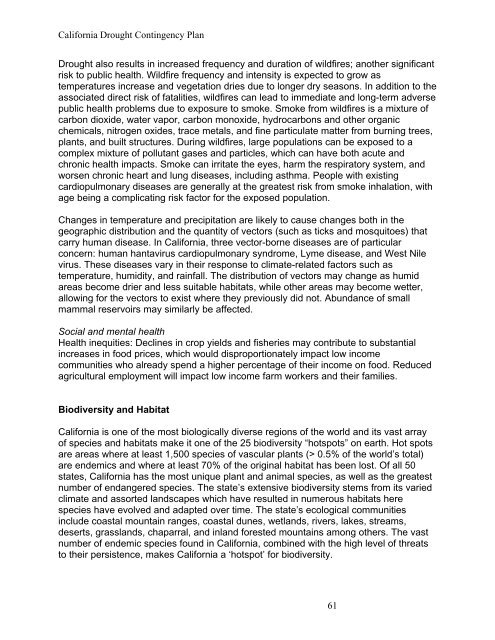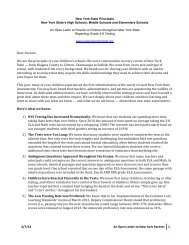Final_CA_Drought_Contingency_Plan-11-18-2010a
Final_CA_Drought_Contingency_Plan-11-18-2010a
Final_CA_Drought_Contingency_Plan-11-18-2010a
Create successful ePaper yourself
Turn your PDF publications into a flip-book with our unique Google optimized e-Paper software.
California <strong>Drought</strong> <strong>Contingency</strong> <strong>Plan</strong><strong>Drought</strong> also results in increased frequency and duration of wildfires; another significantrisk to public health. Wildfire frequency and intensity is expected to grow astemperatures increase and vegetation dries due to longer dry seasons. In addition to theassociated direct risk of fatalities, wildfires can lead to immediate and long-term adversepublic health problems due to exposure to smoke. Smoke from wildfires is a mixture ofcarbon dioxide, water vapor, carbon monoxide, hydrocarbons and other organicchemicals, nitrogen oxides, trace metals, and fine particulate matter from burning trees,plants, and built structures. During wildfires, large populations can be exposed to acomplex mixture of pollutant gases and particles, which can have both acute andchronic health impacts. Smoke can irritate the eyes, harm the respiratory system, andworsen chronic heart and lung diseases, including asthma. People with existingcardiopulmonary diseases are generally at the greatest risk from smoke inhalation, withage being a complicating risk factor for the exposed population.Changes in temperature and precipitation are likely to cause changes both in thegeographic distribution and the quantity of vectors (such as ticks and mosquitoes) thatcarry human disease. In California, three vector-borne diseases are of particularconcern: human hantavirus cardiopulmonary syndrome, Lyme disease, and West Nilevirus. These diseases vary in their response to climate-related factors such astemperature, humidity, and rainfall. The distribution of vectors may change as humidareas become drier and less suitable habitats, while other areas may become wetter,allowing for the vectors to exist where they previously did not. Abundance of smallmammal reservoirs may similarly be affected.Social and mental healthHealth inequities: Declines in crop yields and fisheries may contribute to substantialincreases in food prices, which would disproportionately impact low incomecommunities who already spend a higher percentage of their income on food. Reducedagricultural employment will impact low income farm workers and their families.Biodiversity and HabitatCalifornia is one of the most biologically diverse regions of the world and its vast arrayof species and habitats make it one of the 25 biodiversity “hotspots” on earth. Hot spotsare areas where at least 1,500 species of vascular plants (> 0.5% of the world’s total)are endemics and where at least 70% of the original habitat has been lost. Of all 50states, California has the most unique plant and animal species, as well as the greatestnumber of endangered species. The state’s extensive biodiversity stems from its variedclimate and assorted landscapes which have resulted in numerous habitats herespecies have evolved and adapted over time. The state’s ecological communitiesinclude coastal mountain ranges, coastal dunes, wetlands, rivers, lakes, streams,deserts, grasslands, chaparral, and inland forested mountains among others. The vastnumber of endemic species found in California, combined with the high level of threatsto their persistence, makes California a ‘hotspot’ for biodiversity.61






